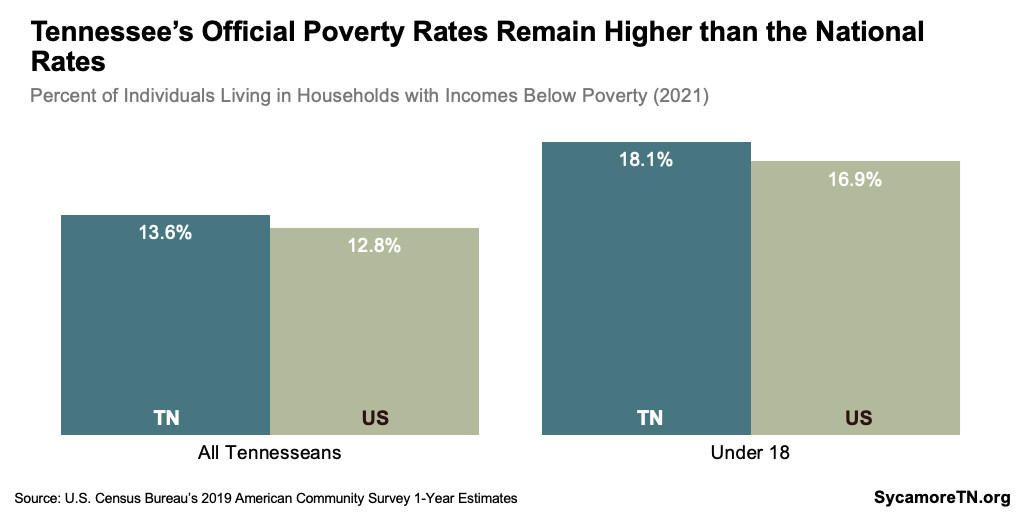
Key Takeaways
- Tennessee saw continued improvements in income and poverty in 2021.
- Median household incomes trended upward over the last decade for black, white, and Hispanic Tennesseans, but differences in their purchasing power also grew.
- Racial and ethnic differences in the poverty rate varied over the last decade but ultimately shrank.
The U.S. Census Bureau released new data in September on income, poverty, education, and health insurance coverage in 2021. These metrics paint a picture of the social and economic circumstances across America.
Here’s what stands out from the 2021 estimates of income and poverty in Tennessee.
Income and Poverty in Tennessee
Tennessee saw continued improvements in income and poverty in 2021. Median household income in the state reached $59,700 last year, meaning half of households had less income and half had more (Figure 1). (1) After adjusting for inflation, that is about a 1% increase from two years before (Figure 2).* (2) (1) Meanwhile, the official poverty rate held relatively steady at 13.6% — compared to 13.9% in 2019 — and child poverty fell 1.6 points to 18.1% (Figure 3). (1) These trends unfolded as earnings grew at every level of education over the last decade — especially among Tennesseans with the least education. See Table A1 in the Appendix for the 2019–2021 data.
Tennessee’s higher rates of poverty and lower levels of income than the U.S. narrowed over the last decade. In 2010, the official poverty rate was 2.4 percentage points higher in Tennessee than nationwide, and the child poverty rate was 4.1 points higher. By 2021, those gaps had narrowed to 0.8 and 1.2 points, respectively (Figure 3). Meanwhile, the gap in median household income remained at about $10,000 between 2010-2021, after adjusting for inflation.
Figure 1
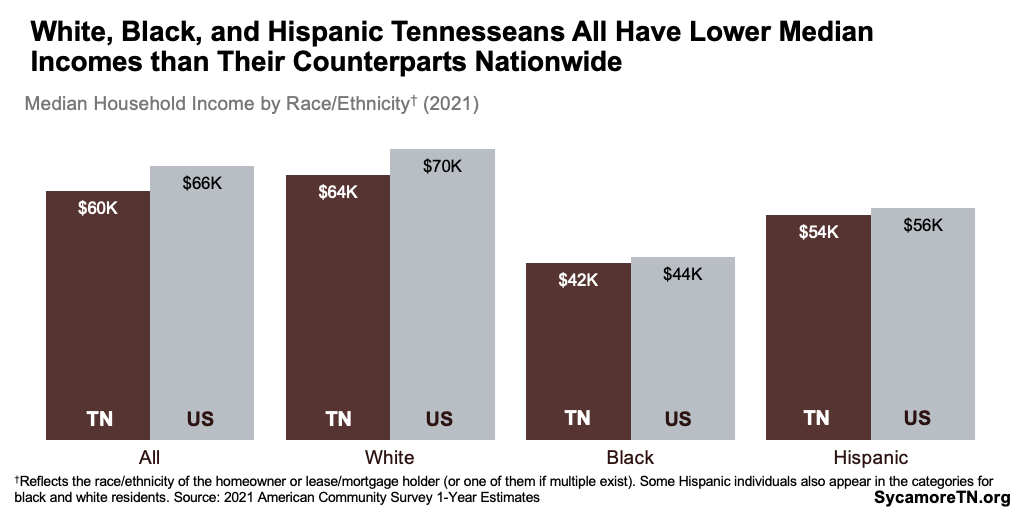
Figure 2
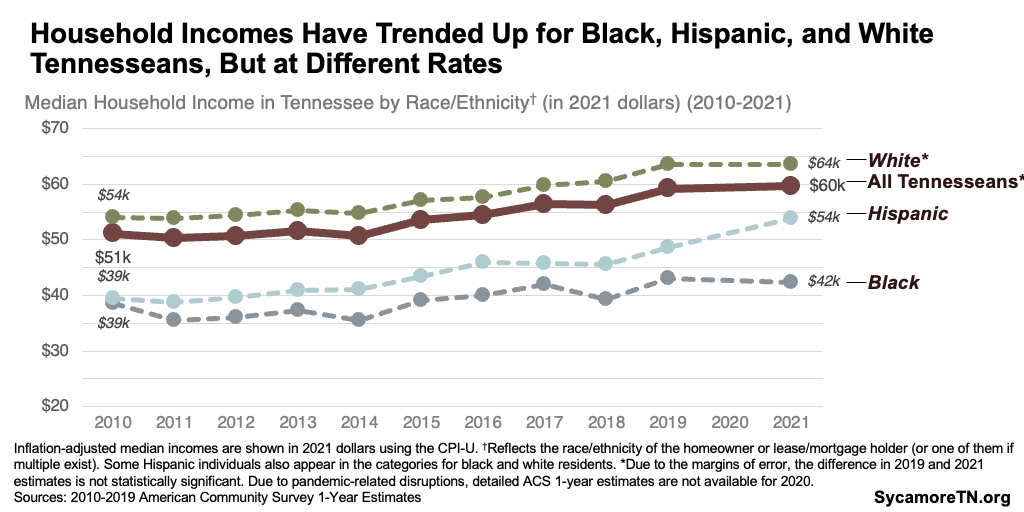
Figure 3

Demographic Variation
Tennessee’s poverty rate and median income vary across race, ethnicity, education level, employment, and household type. In 2021, black Tennesseans, adults without a high school diploma, and unemployed adults had the highest rates of poverty, while white residents, college graduates, and full-time workers had the lowest (Figure 4). In terms of household type, poverty rates were lowest for married couples without children and highest for female-headed, non-married households with children. (Figure 5). (1)
Racial and ethnic differences in the poverty rate varied over the last decade but ultimately shrank (Figure 6). (1) In 2010, the poverty rate among Hispanic Tennesseans was 19 percentage points higher than for whites and 5 points higher than that of black residents. By 2021, the rate was 11 points higher than for white Tennesseans and 2 points lower than that of black residents. Meanwhile, the gap between black and white Tennesseans shrank from 14 points to 11. Since 2014 – when numbers peaked for all three groups, black Tennesseans experienced the largest drop in the number of people under poverty – 30% or about 97,000 people. White and Hispanic Tennesseans both saw about a 26% drop – or 193,000 and 29,000 people, respectively.
Median household incomes trended upward over the last decade for black, white, and Hispanic Tennesseans, but differences in their purchasing power also grew (Figure 2). (1) (2) Adjusted for inflation, Tennesseans’ median household income grew most quickly over the last decade among Hispanics (up 37%), followed by white (up 18%) and black residents (up 10%). In dollar terms, the difference between white and Hispanic incomes shrank by about $4,900 while the gap between white and black incomes grew by $5,700.
Figure 4
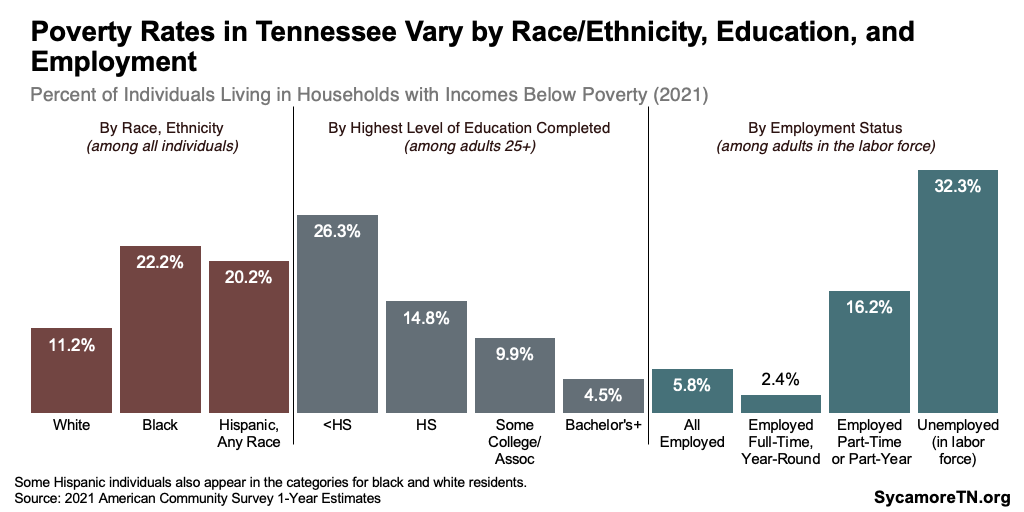
Figure 5
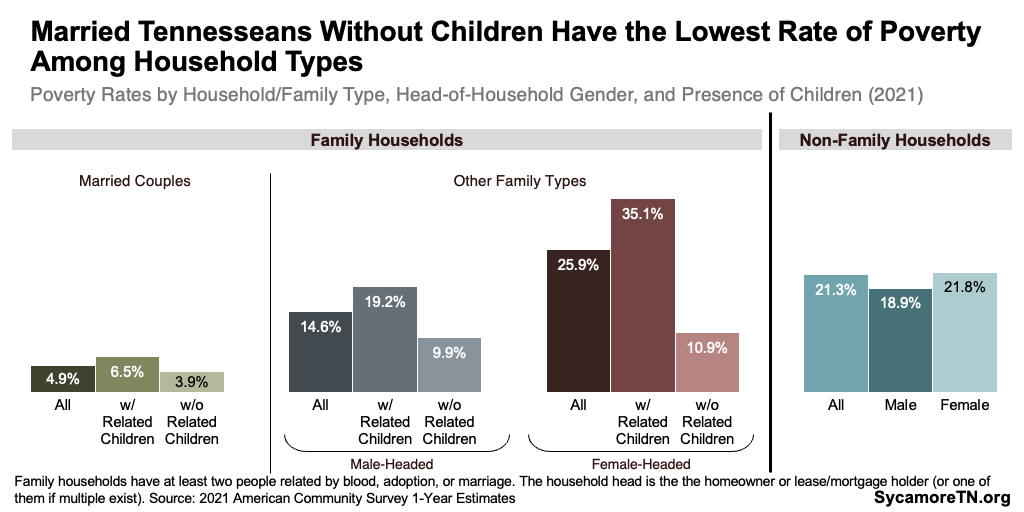
Figure 6
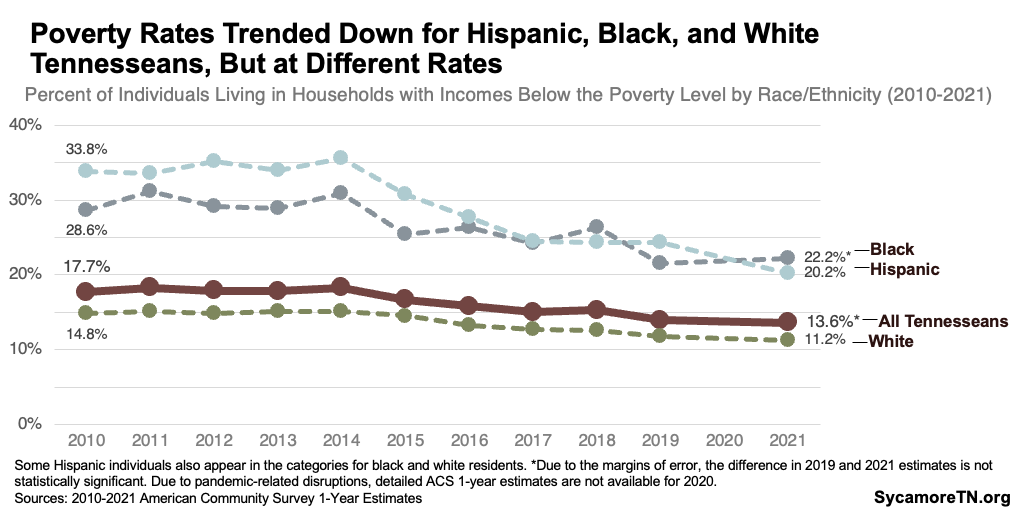
Geographic Variation
Income and poverty rates in Tennessee also vary by geography. The Census Bureau’s September data release includes 2021 estimates for counties with populations above 65,000. Among the 20 Tennessee counties with available data (1):
- Median Household Income — Median household income ranged from nearly $118,000 in Williamson County to about $48,000 in Sullivan County (Figure 7). Six counties experienced a statistically significant increase last year. Due to the margins of error, the difference in all other 2019 and 2021 estimates is not statistically significant.
- Poverty Rate — The official poverty rate varied from 3.5% in Williamson County to 17.9% in Shelby and Sullivan Counties (Figure 8). From 2019 to 2021, statistically significant changes occurred in Greene (down 7 points), Bradley (down 6 points), Maury (up 4 points) and Davidson (up 3 points) Counties.
- Child Poverty — Meanwhile, the poverty rate among residents younger than 18 ranged from 3.5% in Williamson County to 30.1% in Sullivan County (Figure 9). Statistically significant changes occurred in Greene (down 20 points), Knox (down 5 points), Davidson (up 5 points), and Maury (up 13 points) Counties.
See Table A1 in the Appendix for county-specific data for 2019 and 2021.
Figure 7
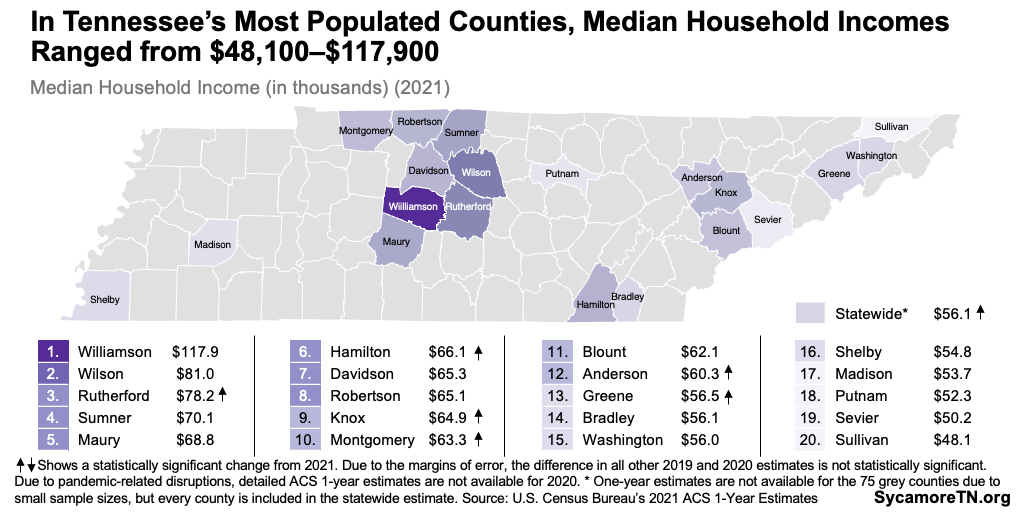
Figure 8
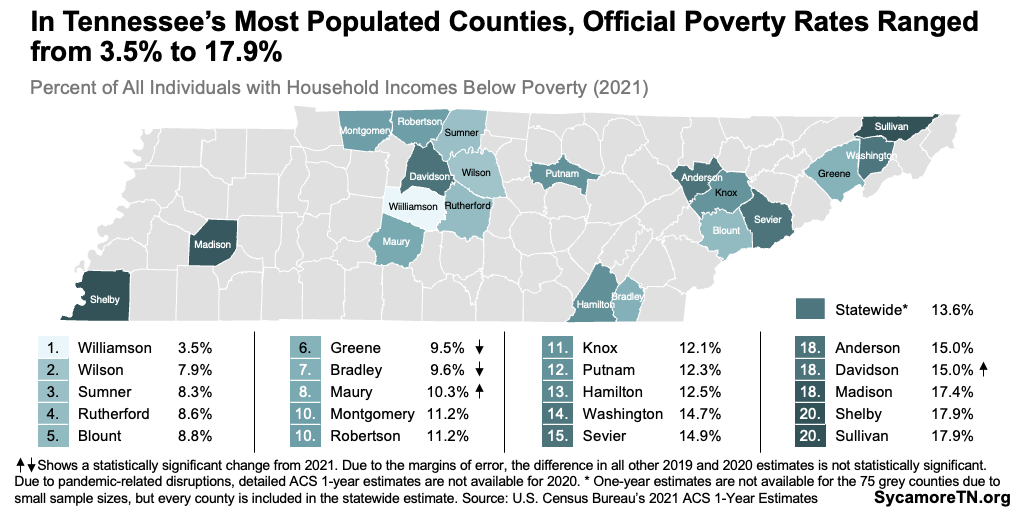
Figure 9
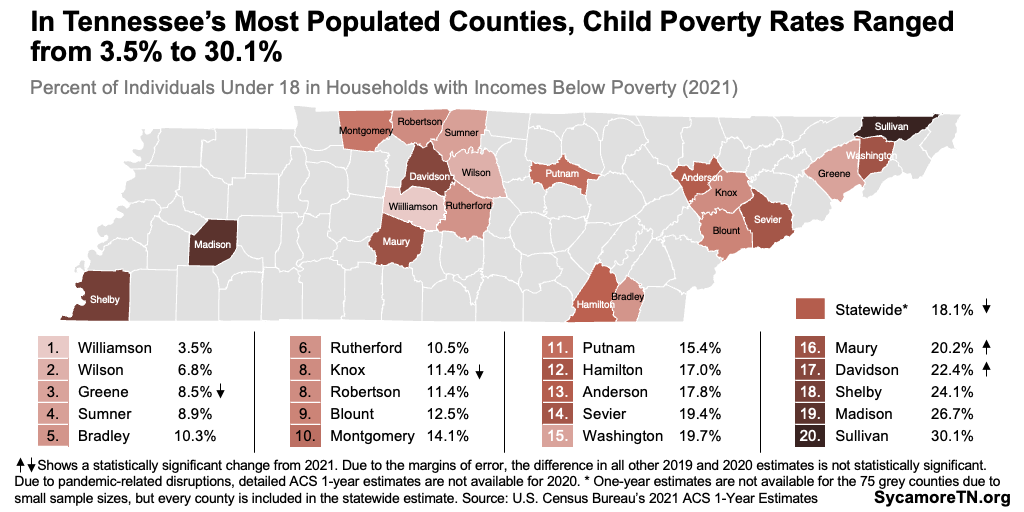
References
Click to Open/Close
- U.S. Census Bureau. 2010-2021 American Community Survey 1-Year Estimates. [Online] September 2022. Available via http://data.census.gov.
- U.S. Bureau of Labor Statistics. Consumer Price Index: CPI-U. [Online] Accessed from https://www.bls.gov.
















